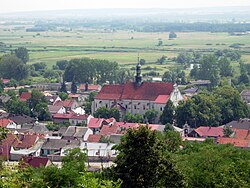Pińczów
| Pińczów | ||
|---|---|---|

Pińczów panorama
|
||
|
||
| Coordinates: 50°32′N 20°32′E / 50.533°N 20.533°E | ||
| Country |
|
|
| Voivodeship | Świętokrzyskie | |
| County | Pińczów County | |
| Gmina | Gmina Pińczów | |
| Area | ||
| • Total | 14.32 km2 (5.53 sq mi) | |
| Elevation | 300 m (1,000 ft) | |
| Population (2013) | ||
| • Total | 11,303 | |
| • Density | 790/km2 (2,000/sq mi) | |
| Postal code | 28-400 | |
| Area code(s) | +48 41 | |
| Car plates | TPI | |
| Website | http://www.pinczow.com.pl/ | |
Pińczów pronounced [ˈpʲiɲt͡ʂuf] is a town in Poland, in Świętokrzyskie Voivodeship, about 40 km south of Kielce. It is the capital of Pińczów County. Population is 12,304 (2005). Pińczów belongs to the historic Polish province of Lesser Poland, and lies in the valley of the Nida river. The town has a station on a narrow-gauge line, called Holy Cross Mountains Rail
In the 12th century in the location of current Pińczów there was a quarry. The miners working at the quarry probably resided in a gord, which was destroyed in 1241, during the Mongol invasion of Poland. In the first half of the 14th century a Gothic castle was erected in the spot where once the gord stood. At the foot of the castle, a settlement appeared, initially called Piedziców, Pandziczów and (1470), Pyandzyczów. The name Pińczów has been in use since the 16th century, and it is not known who was first owner of the settlement. In 1424, it belonged to the powerful Oleśnicki family, which built its residence here, and funded a Pauline monks abbey (1449). On September 21, 1428 in Lublin, King Władysław II Jagiełło granted town charter to Pińczów.
In the mid-16th century, Pińczów became one of main centers of Protestant Reformation in Lesser Poland. The Calvinist nobleman Nicholas Oleśnicki drove out the Catholic monks of Pińczów in 1550 at the instigation of the Italian ex-priest Francesco Stancaro, creating a Calvinist centre, where the Synods of Pińczów were held 1550-1563. Pińczów is sometimes called the Sarmatian Athens for its association with the Calvinist Academy founded by Francesco Lismanino, to which scholars such as the French grammarian Pierre Statorius were invited. The town was the site of the six years of work 1558-1563 for the translators of the Brest Bible, which is why it is sometimes called the Pińczów Bible.
...
Wikipedia


